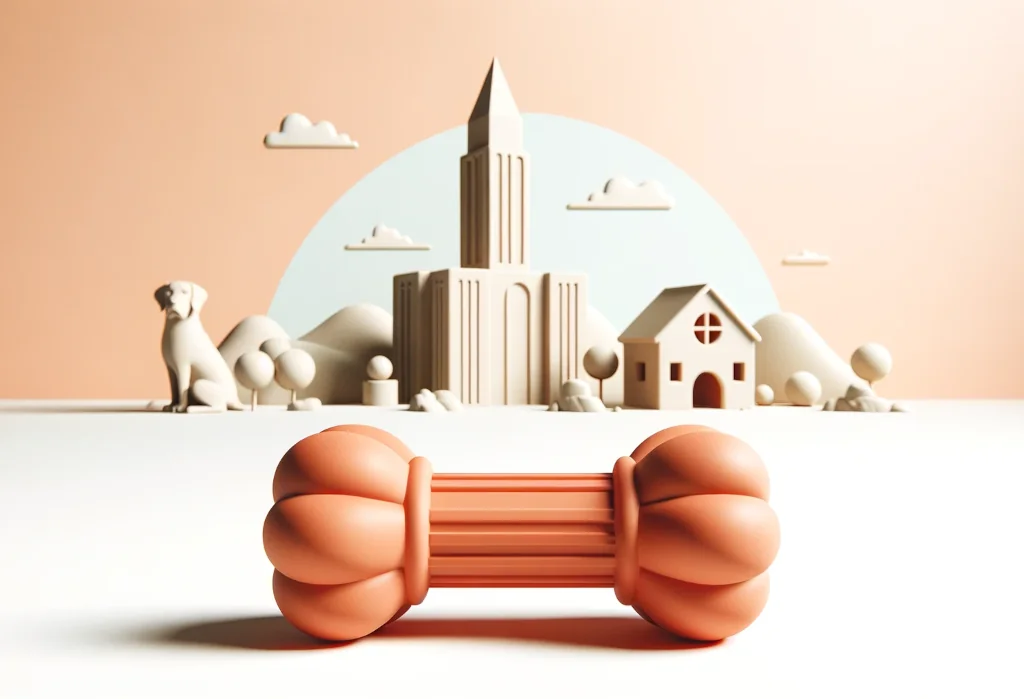Disclosure: We may earn a commission from helpful, relevant links in our content. No cost to you. See our privacy policy.

Nothing ruins a game of fetch faster than a chew toy that quits before your dog does. Picture this: one minute, you’re playing with your furry best friend, and the next, you’re picking up pieces of what once was their favorite toy. We know the struggle, and we’re here to help. In this post, you’ll discover the ins and outs of selecting rubber chew toys that are not only durable but safe for your loving pet.
Quick Takeaways:
- Opt for non-toxic, BPA-free rubber toys to ensure your dog’s chewing is safe from harmful chemicals.
- Test durability with the flex and comparison tests, and always supervise initial play to catch any weaknesses.
- Incorporate vet-recommended toys like the KONG Classic for both dental health benefits and long-lasting entertainment.
What Makes a Rubber Chew Toy Safe for Dogs?
When it comes to keeping our furry friends both entertained and safe, not all toys are created equal. Safety is paramount, and with rubber chew toys, those made from non-toxic, BPA-free materials rank at the top of the list. Here’s the lowdown on what keeps a rubber chew toy out of the doghouse when it comes to safety:
- Non-toxic Materials: Look for toys explicitly labeled as non-toxic. This means they don’t contain harmful chemicals that could leach out during chewing.
- BPA-Free: Bisphenol A (BPA) is a chemical found in many plastics that can be harmful. Opting for BPA-free toys ensures your dog isn’t exposed to this risk.
- Quality Manufacturing: A well-made toy won’t easily break into small, swallowable pieces. It’s not just about the material; it’s also how the toy is crafted.
- Size and Shape: Consider toys appropriate for your dog’s size and chewing habits. A good fit prevents choking hazards and ensures the toy remains interesting to your pooch.
How Can You Test the Durability of a Dog’s Rubber Chew Toy?
Judging a book by its cover won’t cut it when testing the toughness of your dog’s new toy. To give it a real-world chew-over, try these hands-on tactics:
- The Flex Test: Give the toy a good bend and twist. A durable toy should be flexible enough to not break but firm enough to spring back into shape.
- The Comparison Test: Hold it up against a toy you know has endured the jaws-of-life test by your canine. If it feels significantly softer or more brittle, its durability may be questionable.
- Supervised Play: Before letting your dog have at it solo, observe how the toy holds up under direct supervision. This gives you a chance to intervene if any pieces come loose.
Remember, no toy is indestructible, but these tests can help you weed out the weaklings.
Are There Chew Toys That Veterinarians Recommend?
Indeed, there are! Some toys stand tails above the rest, having earned accolades from veterinarians and pet professionals alike. Most adored are those that marry durability with dental health benefits. Here are a few rubber chew toys that tick these boxes, and then some:
- KONG Classic Dog Toy: A perennial favorite, its unique shape and durable rubber make it ideal for chewers of all sizes. Plus, it can be stuffed with treats to keep your pup engaged longer.
- GoughNuts Chew Toys: Designed with safety in mind, GoughNuts toys have a two-layer design that indicates when the toy has been chewed to a point where it’s unsafe.
- West Paw Design Zogoflex: Highly durable and recyclable, these toys are a hit with eco-conscious pet owners and dogs alike. They’re also dishwasher safe, making cleanup a breeze.
Unique to our list, and something not all dog owners are aware of, is the importance of choosing a toy that encourages active engagement. Toys that can be chewed in a variety of ways or can be used in play help maintain your dog’s interest and promote healthier, longer-lasting chew sessions. For instance, the KONG Classic can be used in a game of fetch in addition to being a chew toy, doubling its utility and entertainment value.
Remember, while these toys come highly recommended, always observe how your dog interacts with a new toy. Every dog is unique, and what works for one may not work for all. Safety first, and happy chewing to your furry friend!
Can Chew Toys Impact a Dog’s Dental Health?
Absolutely! Think of rubber chew toys as a toothbrush’s fun cousin. They don’t just distract your furry friend from chewing on your favorite sneakers; they’re also ace at keeping their teeth sparkling clean. Here’s the scoop: when your dog gnaws on a specifically designed rubber chew toy, it creates a scrubbing effect on their teeth. This action helps to reduce plaque and tartar buildup, which in turn, can prevent dental diseases like gingivitis.
But here’s the kicker, not all chew toys are created equal. Some are better at this cleaning action than others. Toys with raised nubs or ridges are particularly good because they can reach into the little nooks and crannies between your dog’s teeth, giving them a thorough cleaning. Additionally, some chew toys are infused with flavors that not only make them more appealing to your pooch but can also include ingredients that promote dental health.
Remember though, while these toys are helpful, they don’t replace the need for regular veterinary check-ups. Think of them as part of a comprehensive dental care routine that includes professional cleanings and at-home tooth brushing.
Unique Insight : Did you know that certain rubber chew toys can alter the pH of your dog’s saliva, making it less hospitable for bacteria? It’s a fascinating area of study and a potential game-changer in preventive oral health for our canine companions. However, it’s essential to choose these toys wisely, as not all of them deliver on this promise.
What to Do if Your Dog Breaks Their Chew Toy?
First off, don’t panic. It’s pretty common for tenacious chewers to break through even the most durable toys. Here’s what you should do:
-
Inspect and Remove : Immediately take the broken toy away from your dog. Check their mouth for any small pieces that might have been ingested or stuck.
-
Assess the Situation : Was the toy old or not suitable for your dog’s chewing power? This can be a valuable learning moment to understand what type of toy is best for your pet.
-
Choose a Replacement Wisely : Look for a toy that’s designed for heavy chewers. Brands like Kong and Nylabone have excellent options that are made specifically to withstand a lot of bite pressure. Consider the size, shape, and material of the toy. A too-small toy can be a choking hazard, while a too-hard toy may damage your dog’s teeth.
-
Monitor Playtime : Especially with a new toy, watch how your dog interacts with it. This will help you gauge its durability and whether it’s a good fit for your pup’s chewing habits.
-
Safety First : Regularly inspect the toy for signs of wear and tear, and replace it before it breaks. It’s also a smart idea to have a ‘rotation’ of toys, so your dog doesn’t get too fixated or aggressive with one.
Pro Tip : Consider reaching out to the manufacturer if the toy broke too easily. Some companies offer a replacement guarantee if the toy doesn’t hold up as expected. This could save you money and also help you find the most durable option for your chew-happy friend.
Innovative Suggestion : Create a DIY puzzle toy by putting healthy treats inside a sturdy rubber toy. It’ll not only keep them busy trying to get to the treats but also indirectly promote gentle chewing habits, reducing the risk of breaking their toys too quickly. Plus, it’s a fun mental exercise for them!
Remember, selecting the right chew toy and knowing what to do if it breaks is all about understanding your dog’s health, happiness, and safety. By following these practical tips, you’re not just choosing a plaything; you’re investing in your dog’s overall well-being.
Alex, a passionate animal lover, has experience in training and understanding animal behavior. As a proud pet parent to two dogs and three cats, he founded AnimalReport.net to share insights from animal experts and expand his knowledge of the animal kingdom.




